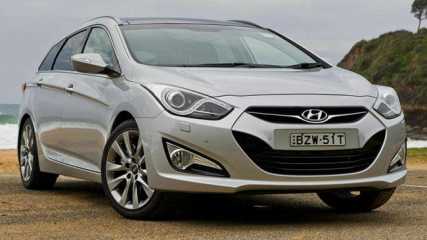Mazda CX-5 auto 2012 review
By John Parry · 08 Aug 2012
The CX-5 is proving yet another hit for Mazda with nearly 8000 sold since its launch in March, almost as many as the Toyota RAV 4 has sold since January. About 40 per cent of them have been diesels.There are many model choices. Entry level is the Maxx FWD petrol manual at $27,800 (auto $29,800, then comes the Maxx AWD petrol auto at $32,300, the Maxx Sport FWD petrol auto at $33,540, Maxx Sport AWD auto petrol at $36,040, the Maxx Sport diesel AWD at $39,040, the Grand Touring AWD petrol auto $43,200 and the Grand Touring AWD diesel auto at $46,200.Standard equipment includes six airbags, stability control, a reversing camera, a 5.8-inch touch screen, cruise control, Bluetooth, single CD audio with iPod, USB and MP3 connection, keyless push-button start, tilt and telescopic steering column, tyre pressure monitoring, a 60-40 split flat-folding, rear seat and a temporary spare wheel.The Maxx Sport adds 17-inch alloy wheels, satellite navigation, dual-zone climate control, auto headlights and wipers, fog lights and a 40-20-40 split rear seat. The GT adds a sunroof, leather seats, 19-inch alloy wheels, Bose audio, front and rear parking sensors, bi-xenon adaptive headlights, day lights, power driver's seat and heated front seatsThe two-litre petrol engine might be frugal but it is not exactly punchy, developing 114kW and 205Nm and mated to either a six-speed manual or automatic.Its forte is frugality, using a combined 6.4l/100km in the front-wheel drive (FWD) version and 6.9l/100km in the all-wheel drive (AWD). Output from the two-litre turbo diesel is 129kW and 420Nm, making it the most powerful in its class. Fuel use on the combined cycle is just 5.7l/100k, not much less than the petrol so the $3000 premium for the diesel is hard to justify on fuel alone.The CX-5 replaces the CX-7 and although it is shorter and narrower, it has more useable interior space, more hip and legroom and a bigger boot with a lower load height. It is also lighter by about 50kg.Styling has that Mazda family look although the protruding wombat-like nose is not its best angle. The interior is spacious. There are numerous storage options and the finish is impressive. The front seats are supportive, with ample adjustment travel, and the spacious split-fold back seat folds flat in one motion.The automatic on test was at best pottering around town or cruising on level to undulating terrain, but showed a dislike for hills due to its modest torque and need for higher revs. Not helping is the transmission which is programmed to pick up higher ratios as soon as possible, so it constantly hunts between ratios under load and needs constant coaxing on the throttle to maintain cruising speed.In line with Mazda's sporty image, the suspension is on the firm side of comfortable -- compliant enough over big bumps and smooth roads but fidgety over secondary surfaces. Handling is accurate and involving with minimal body roll, the brakes are strong and the rack-and-pinion steering is accurate and well-weighted. Noise levels are low apart from tyre roar on coarse chip surfaces.Despite limited wheel travel, underbody clearance is sufficient for modest off-road forays. But it's the case of economy at the expense of driveability. The diesel, available in AWD auto only, is a much better prospect.The payback comes in performance. With more than twice the torque, it leaves the petrol in its wake for composure and flexibility. And for those who live in the hills, tow or regularly drive with a full load, it will be the preferred option.














.jpg)